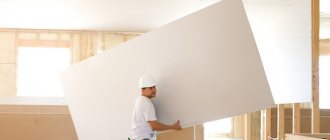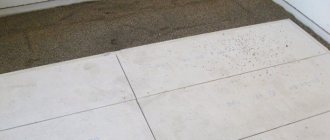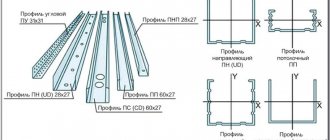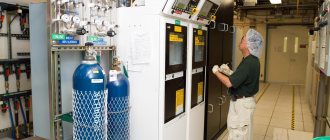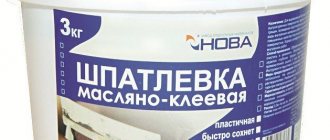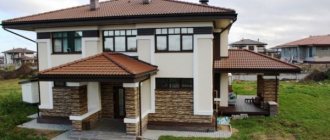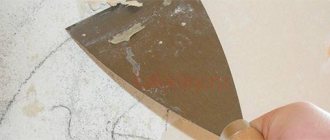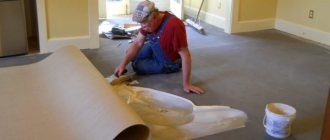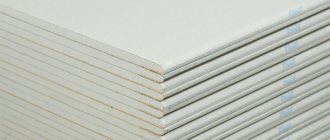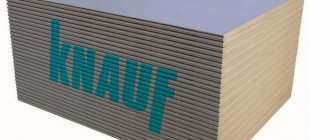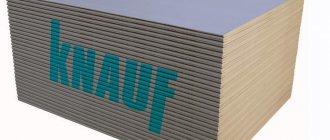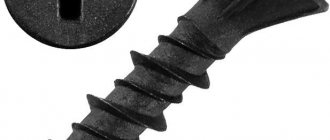International GOST 6266 97 has been in force since April 1, 1999. It was adopted as a Russian standard by Gosstroy Resolution No. 14.
According to the Rosstandart catalog for GOST 6266 97, the status for 2015 is determined as a valid document.
Used on a voluntary basis by manufacturers, trading organizations and contractors when performing work.
For individual homeowners, it is useful as a reference for determining material quality, properties and application possibilities.
Structure and features of plasterboard sheet
If renovations are underway somewhere, then we can say with confidence that plasterboard will certainly be one of the building materials. It is very popular and in demand, as it is great for finishing apartments and houses. This material is inexpensive, completely harmless and non-flammable, and has good soundproofing properties. It can take away excess moisture from the air, and then easily give it away if the air dries out. Working with drywall is pleasant and easy - it is not capricious and is easy to process.
Builders especially like the lightness of plasterboard sheets - this is a big plus both during installation and during transportation. When working with drywall, little waste is generated, and removing debris is much faster. The use of plasterboard in construction is the so-called “dry construction”.
Ease of use of the material
It is very convenient that for drywall you do not need a special tool at all - the minimum that is available in every home is enough. Complex structures can be created from this material due to its special properties. Just wet the plasterboard sheet and you can do whatever you want with it. For example, bend it in the form of an arch, build a niche, or bring to life an intricate design project. After drying, the structure will retain its shape. By the way, smooth surfaces also turn out excellent.
Thanks to the use of plasterboard, you can significantly reduce the time spent on finishing work. Let's take, for example, the manufacture of a partition. If you make it from traditional building materials (say, brick), you will have to spend three times as much time. And drywall does not cause allergic reactions, which is also a positive quality.
What are the disadvantages of drywall?
Unfortunately, there are properties and characteristics of drywall that do not add to its advantages. So, this material cannot boast of strength and water resistance. In addition, it is difficult to attach anything to it. It is useless to make holes in a plasterboard wall with nails - only dowels and screws can hold a shelf or a picture on it. But still, you shouldn’t hang anything particularly heavy, as this can lead to complete destruction of the wall.
Insufficient water resistance
Insufficient strength
Difficult to mount on the wall
Installation of plasterboard sheet
Nothing complicated - the design corresponds to the name. The core is made of gypsum with additives, and the outside is lined with cardboard. It is held tightly with special glue. Depending on the application, types of plasterboard with different properties are produced.
Characteristics of drywall
EuroProfile → Technical documentation → Characteristics of drywall
General information
Plasterboard sheets are a construction and finishing material used for wall cladding, interior partitions, suspended ceilings, fire-retardant coatings for structures, as well as for the manufacture of decorative and sound-absorbing products.
When using plasterboard sheets in the process of finishing work, inconvenient “wet” processes are eliminated, labor productivity increases significantly, the opportunity to implement unlimited in design, multi-variant architectural solutions is provided, including the installation of curved surfaces, overall savings in construction costs are achieved due to the lightweight construction of the building, only environmental cleanliness, but also a favorable indoor microclimate for humans.
KNAUF plasterboard sheets are produced in accordance with GOST 6266-97. Their production is carried out on modern equipment (France), which, since 1994, has been constantly improved with the participation (Germany), one of the leading European manufacturers of plasterboard sheets, which currently allows us to produce products with characteristics that meet strict international standards.
Production and composition
The technological process for the production of plasterboard sheets includes the formation on a conveyor of a continuous flat strip with a cross-section of a given shape (the required thickness and type of side edges), 1200 mm wide, consisting of two layers of special cardboard with a layer of gypsum dough with reinforcing additives, while the side edges of the strip are rolled edges of cardboard (face layer). Next, after the gypsum “sets,” the strip is cut into separate sheets, as well as drying, labeling, stacking and packaging of the finished product.
To form the core, gypsum is used, which has exceptional physical and technical properties as a building material. Gypsum-based materials have the ability to breathe, that is, absorb excess moisture and release it into the environment when there is a deficiency. Gypsum is a non-flammable, fire-resistant material, it does not contain toxic components and has an acidity similar to that of human skin, its production and use does not have a harmful effect on the environment. To achieve the required parameters of a gypsum core, characterizing its strength, density, etc., special components are added to it to increase its performance properties.
Another important component of drywall is the facing board, the adhesion of which to the core is ensured through the use of adhesive additives. Cardboard plays the role of a reinforcing shell, and at the same time it is an excellent basis for applying any finishing material (plaster, wallpaper, paint, ceramic tiles, etc.). Due to its physical and hygienic properties, cardboard is ideal for residential premises.
Types of sheets, their features and applications
| Designation | Type of drywall | a brief description of | Application area | Cardboard color | Marking color |
| GKL | Regular | grey | blue | ||
| GKLO | With increased resistance to open flames | They differ from conventional ones by special reinforcing additives in the core material | Used in buildings and premises with dry and normal humidity conditions according to SNiP II-3-79* | grey | red |
| GKLV | Moisture resistant | They differ from conventional ones in special impregnated cardboard, as well as hydrophobic and antifungal additives in the core material | They are used in the same way as conventional gypsum plasterboards, as well as in buildings and rooms with damp and wet humidity conditions according to SNiP II-3-79* with the provision of exhaust ventilation and subject to protection of the front surface, for example: waterproofing, waterproof primers, paints, ceramic tiles, PVC coatings | green | blue |
| GKLVO | Moisture-resistant with increased resistance to open flames | They differ from conventional ones in the combination of properties of GKLO and GKLV | green | red |
Sheet sizes
In shape, plasterboard sheets are rectangular elements with the following nominal geometric dimensions:
| Length, mm | from 2000 to 4000 in increments of 50 | |
| Width, mm | 600; 1200 | By agreement between the manufacturer and the consumer, it is possible to produce sheets of other sizes |
| Thickness, mm | 6,5; 8,0; 12,5; 14,0; 16,0; 18,0; 29,0; 24,0 |
Sheet groups
According to the tolerance for sheet length and the number of external permissible defects, plasterboard sheets in accordance with GOST 6266-97 are divided into two groups: A and B. KNAUF produces sheets only of the highest group - A.
Edge Types
| Section | Longitudinal edge type | Designation | Application |
| Straight | PC | For dry installation, without sealing the joint | |
| Refined | UK | For installation, taking into account subsequent sealing of the joint with Fugenfüller putty with reinforcing tape | |
| Semicircular on the front side | PLC | For installation, taking into account subsequent sealing of the joint with Uniflot putty without reinforcing tape | |
| Semicircular and thinned on the front side | PLUK | Universal edge for installation, taking into account subsequent sealing of the joint with putty: “Uniflot” - without reinforcing tape; "Fugenfüller" - with reinforcing tape | |
| Rounded | ZK | For installation taking into account subsequent plastering |
The end edges of the sheets are rectangular in shape and when making a seam it is necessary to chamfer them (approximately 1/3 of the sheet thickness).
Symbol
The symbol for plasterboard sheets consists of: a letter designation of the type of sheet; sheet group designations; designations of the type of longitudinal edges of the sheet; numbers indicating the nominal length, width and thickness of the sheet in millimeters; standard designations.
An example of a symbol for a conventional plasterboard sheet of group A, with thinned edges, 2500 mm long, 1200 mm wide and 12.5 mm thick: GKL-A-UK-2500×1200×12.5 GOST 6266-97.
Strength
The bending strength of plasterboard sheets is assessed based on the results of testing several samples (3 longitudinal and 3 transverse) from a batch. Tests are carried out on samples 400 mm wide, mounted on supports with a span of L = 40×S, where S is the sheet thickness. The test results (arithmetic mean) must correspond to the data in the table.
| Sheet thickness, mm | Breaking load, N (kgf), not less | Deflection, mm, no more | ||
| for longitudinal samples | for transverse samples | for longitudinal samples | for transverse samples | |
| to 10 | 450 (45) | 150 (15) | — | — |
| from 10 to 18 (incl.) | 600 (60) | 180 (18) | 0,8 | 1,0 |
| over 18 | 500 (50) | — | — | — |
The strength of sheets produced by KNAUF exceeds the minimum permissible values. For example, for sheets with a thickness of 12.5 mm, the breaking load for longitudinal samples is sometimes 730 N.
| Sheet type | Weight 1 sq. m, kg | |
| GKL | no more than 1.0×S | S - nominal sheet thickness in mm |
| KLO, GKLV, GKLVO | from 0.8×S to 1.06×S |
The weight of a regular KNAUF sheet with dimensions 2500×1200×12.5 mm (3 m²) is about 29 kg.
Fire technical characteristics
Gypsum plasterboard sheets GKL, GKLV, GKLO, GKLVO belong to the flammability group G1 (according to GOST 30244), to the flammability group B3 (according to GOST 30402), to the smoke generating ability group D1 (according to GOST 12.1.044), to the toxicity group T1 (according to GOST 12.1.044).
Transportation and storage
GCRs are transported by all modes of transport in accordance with the rules for the transportation of goods in force for this type of transport, in packaged form. The package is formed from sheets of the same group, type and size, laid flat on pallets or pads made of wood or plasterboard strips and other materials, usually tied with steel or synthetic tape and packaged in heat-shrinkable polyethylene film.
Transportation and storage of KNAUF plasterboard sheets requires compliance with certain rules:
- the dimensions of the transport package (with pallet or spacers) should not exceed 4100×1300×800 mm, weight - no more than 3000 kg;
- the stack formed from packages during storage should be no higher than 3.5 meters;
- when transporting transport packages in open railway and road vehicles, the packages must be protected from moisture;
- During loading and unloading, transport, storage and other operations, impacts on sheets are not allowed;
- GCR should be stored in a closed, dry room with dry or normal humidity conditions, separately by type and size.
Types of drywall and their areas of application
Wall plasterboard (GKL)
The sheets can have a length of 2.3 or 2.5 m. The width of any of them is 1.2 m. The thickness of this material is 12.5 mm, its color is gray. There are markings on the cardboard in blue. There are no special additives in the core; the properties of the material are standard.
Plasterboard ceiling
The length of the sheets can be 2 or 2.5 m, and the width - 1.2 m. The thickness is less than that of wall material - it is equal to 9.5 mm. The light gray cardboard facing is similarly marked in blue. This type of gypsum board is used for cladding ceilings, as well as for the manufacture of niches, arches and multi-level ceiling structures. The properties are similar to the previous type, differing from it only in thickness. Thanks to this, by the way, it costs the least.
Moisture-resistant drywall (GKLV)
Sheets 2.3 and 2.5 m long have a standard width of 1.2 m. The thickness is the same as that of wall material (12.5 mm). The facing cardboard is green and has blue markings. These gypsum plasterboards are used in rooms with excess humidity, which they can easily tolerate. You can improve this characteristic of moisture-resistant drywall if you additionally cover the walls with waterproofing material.
Paint, primer or a layer of tile can also serve in this capacity. Both the core and the cardboard of this material have a special composition, so they are not afraid of moisture. For this, antifungal impregnation and special additives are used.
Fire-resistant drywall (GKLO)
The length of its sheets can be 2, 3 and 2.5 m, and the usual width and thickness are 1.2 m and 12.5 mm. The facing cardboard is light gray in color and all markings on it are red. GCR data is used where fire safety requirements are high. For example, this could be the lining of a chimney or fireplace. This type of drywall has a large amount of fibers and additives in its core intended for reinforcement. This structure, reinforced with an external cardboard lining, is difficult for fire to overcome. After all, it turns out to be a double frame.
Note that durable cardboard used in any gypsum boards does not burn and does not contribute to combustion. Maximum - it gets charred. But the core can only resist fire in a fire-resistant type of drywall. In case of fire, it does not collapse and retains its shape.
Moisture-resistant plasterboard (GKLVO)
Combines the properties of moisture-resistant and fire-resistant plasterboard sheets.
Arched plasterboard (flexible)
Its light gray sheets have only one length - 3 m. The width, as usual, is 1.2 m. But the thickness of the material is small - only 6.5 mm, so it is mainly installed in two layers. Arched plasterboard is used to make various curved products with different bending radii. They can be bent so easily thanks to the fiberglass threads that strengthen the core. However, due to this, the price of the sheets is quite high. And the fact that they have to be laid in a double layer further increases costs.
Properties of plasterboard sheet
The most important properties of plasterboard sheets that you need to know when purchasing them are moisture resistance and fire resistance. These and some other properties of the drywall sheet are “coded” in the sheet markings.
Knauf drywall sheet markings
- GKL - Ordinary plasterboard sheet (GSP-A, PLUK edge);
- GKLV - Moisture-resistant plasterboard sheet (GSP-N2);
- GKLO - Fire-resistant plasterboard sheet (GSP-DF);
- GKLVO - Moisture-resistant plasterboard sheet with increased open flame resistance (GSP-DFH3IR).
Note: Since 2022, the marking of Knauf plasterboard sheets, which are correctly called Knauf super-sheet, has changed. The new sheet markings are shown in brackets. Basic release of all sheets with PLUK edge.
Moisture-resistant sheets are used for walls and ceilings in wet rooms, such as bathrooms, toilets, showers, provided they are protected with finishing materials (tiles, paint) or waterproofing impregnations.
Ordinary sheets of drywall in damp rooms begin to swell over time, compromising the integrity of the finishing coating.
Nomenclature of plasterboard sheets Giprok
- GKL - Standard plasterboard sheet
- GKLV - Moisture-resistant plasterboard sheet;
- GKLU - Reinforced plasterboard sheet;
- GKLVU - Moisture-resistant reinforced plasterboard sheet;
- GKLO - Fire-resistant plasterboard sheet;
- GKLZ - windproof plasterboard sheet;
- GKLD - Design plasterboard sheet.
Types of gypsum board edges
The standard width of the sheets is 1.2 m. They are manufactured in accordance with GOST 6266-97: inside two layers of durable cardboard there is a hardened mass of gypsum with special additives for reinforcement. The lateral and longitudinal sides of the sheet are wrapped in cardboard.
There are several types of edges used in the production of drywall. This is made for more convenient processing of joints between sheets. It is worth remembering that all ends of gypsum boards are always only rectangular. If there is a need to join exactly these sides (the short ones), then they need to be chamfered by about a third.
| PC (straight edge) is used when joints do not need to be sealed. |
| UK (edge with thinning) is needed if reinforcing tape and putty are used for sealing. |
| PLC (face semicircular edge) is used when working with putty and without reinforcing tape. |
| PLUK (front semicircular edge with thinning) can be used when working with putty and with reinforcing tape, and without this tape. |
| ZK (rounded edge) is used if the joints are to be sealed with plaster. |
Drywall sheet dimensions
Speaking about the size of the drywall sheet, I would like to note the following. Sheet sizes are regulated by GOST 6266-97 “Gypsum plasterboard sheets”. This GOST was developed with the participation of the Tigi Knauf joint venture and, as a result, all plasterboard sheets produced by Knauf exactly comply with the requirements set out in GOST 6266-97 (link at the bottom of the article).
Knauf plasterboard sheets are available in lengths from 2000 mm (2 meters) to 4000 mm, in increments of 500 mm. That is, you can find plasterboard sheets on sale with lengths of 2000; 2500; 3000; 3500; 4000 mm.
- The width of the Knauf plasterboard sheet is 600 or 1200 mm.
- The thickness of the Knauf plasterboard sheets is 6.5; 8.0; 9.5; 12.5; 14.0; 16.0; 18.0; 20.0;24.0 mm.
Unlike Knauf sheets, Giprok plasterboard sheets are produced in other sizes, which does not prevent them from having a Certificate of Conformity (Nq PoCC El.AI09.H004, valid 09.26-2014) allowing its use in Russia. By the way, the certificate of conformity was issued on the basis of the same GOST 6266-97.
Giprok plasterboard sheet is available in lengths of 2500, 2550, 2600, 2700, 2750, 3000, 3300, 3600 mm.
- The width of gypsum board sheets is generally 1200 mm. Less often 900 mm.
- The thickness of the gypsum boards is 6.5; 9.5; 12.5; 15.4 mm. The thickness of the sheets varies depending on their properties.
Flammability of drywall
Drywall is not a flammable material, and it can also withstand fire for a long time. As a matter of fact, any gypsum-containing materials can boast of such qualities.
- GOST 30244 determines flammability - it is for G1 plasterboard;
- GOST 30402 determines flammability, for plasterboard it is B2;
- GOST 12.1.044 determines the ability to generate smoke; according to this indicator, plasterboard belongs to group D1;
- GOST 12.1.044 defines toxicity; drywall belongs to group T1.
In the event of a fire, the characteristics of fire-resistant plasterboard allow it to withstand fire. The gypsum itself cannot burn, and after the cardboard is destroyed, the core simply crumbles. To increase fire resistance, partitions are made from two sheets of plasterboard. Thus, cardboard located between two sheets is able to withstand fire for a longer time.
Drywall sheets
Drywall is produced in sheets. A sheet of drywall has a certain length and width, and different thicknesses. Drywall sheets differ not only in size, but also in properties. The distinctive properties of plasterboard sheets are moisture resistance (moisture resistance), resistance to open flames (fire resistance), and increased impact resistance. Also, the plasterboard sheet has differently made end edges on the long side of the sheet.
The drywall sheet has a rectangular shape. Technologically, a sheet of plasterboard has a front and an inner side. All factory markings of the sheet (company name, size, lot number) are applied to the inside of the plasterboard sheet. The outside is clean. Also on the outside of some types of sheets, a thinned edge is made.
Water absorption and softening coefficient
For brands of drywall that are moisture resistant (including those that are also fire resistant), moisture absorption of no more than 10 percent is permissible. Drywall also has another important parameter - the softening coefficient Kp, which is calculated by dividing the tensile strength in a water-saturated state (Rн) by the tensile strength in a dry state (Rс).
If we talk about sheets of ordinary drywall, their strength is significantly reduced when they are heavily moistened. There are quite a lot of similar materials sold, and they all have a small softening coefficient of approximately 0.8. But gypsum board has a slightly different value for this parameter - 0.45. This means that after getting wet, the strength of this material will greatly decrease.
Varieties
Modern manufacturers produce 4 main types of construction plasterboard:
- Standard. Gray in color, characterized as dry plaster for interior decoration with normal humidity.
- Moisture resistant. Green in color, it is resistant to dampness, fungi and mold.
Types of construction drywall Source stroy-podskazka.ru
- Fire resistant. Red in color, prevents fire.
- Moisture and fire resistant. Green in color, characterized by resistance to fire and humidity at the same time.
If ordinary gypsum board has a density of 800 kg/m³, then its fire-resistant analogue, due to the compacted fire-resistant gypsum included in the composition, is about 850 kg/m³. At the same time, increased strength and fire resistance is achieved by the presence of several impregnated layers.
Recommendation! One of the main disadvantages of drywall is its lack of strength with respect to external fasteners. Therefore, to mount heavy objects on the wall, it is necessary to use brackets with an increased contact area to maximize the distribution of the weight of the object being mounted over the surface.
Thermal conductivity of drywall
To begin with, it should be noted that drywall retains heat quite well. The thermal conductivity coefficient of plasterboard ranges from 0.22 to 0.35 W/ (m×K). This is not bad - after all, when carrying out repairs, you can immediately make the walls even and slightly improve their thermal insulation. It should be noted that this method of thermal insulation of walls is inexpensive, fast and effective. And if you make a gap from 3 to 10 mm, then an additional air layer will appear, which will help conserve heat even better.
To achieve a good result in terms of thermal conductivity, various insulation materials are placed in the cavity between the insulated wall and the plasterboard. This could be, for example, mineral wool or ordinary polystyrene foam. The further we move the plasterboard away from the wall, the thicker the additional thermal insulation layer can be made.
Characteristics
A standard fire-resistant plasterboard sheet has the following set of technical characteristics:
- Dimensions – 250x120x1.25cm.
- Weight – 30kg.
- The category of combustion ability is G1 (corresponds to fireproof).
- Flammability class – B1 (meets fire resistance).
- Toxicity degree – T1 (non-toxic).
- Density – 850 kg/m³.
Finishing a fireplace using gypsum plasterboard Source gipsokarton-blog.ru
- The ability to conduct heat is 0.22 W/m².
- Smoke generation – D1 (does not produce smoke when exposed to fire).
Important! When choosing gypsum plasterboard for home finishing, among the main technical characteristics that you should pay attention to are fire-fighting properties (maximum temperature), as well as how fire-resistant and harmless the plasterboard is in terms of toxicity. This information is contained in the quality and fire safety certificate.
About the thickness of sheets
Drywall, which is sold in stores and on the market, most often can be 6, 9, 12 mm thick. The thinnest gypsum boards, 6 mm thick, are used for the “wet method” - they are used to make complex curved products (arches, designer structures, niches). A thickness of 9 mm is well suited for bending sheets “dry” and creating the same arches - experienced craftsmen usually do this. Ceilings are also made from nine-millimeter gypsum boards in order to reduce the weight of the structure. The thickest sheets are used for cladding walls and creating partitions. Other sizes are extremely rare on sale, and therefore, as a rule, they are not of interest to the average buyer.
Briefly about the main thing
Fire-resistant plasterboard contains gypsum modified with clay and glass fibers at its core, and is covered on the outside with cardboard impregnated with fire retardants. Thanks to this structure, the material is able to hold back fire for 20 minutes to 1 hour without destruction. Its main advantages:
- Fire protection.
- Harmlessness.
- Moisture resistance.
- Sound and heat insulation.
- Durability.
- Versatility.
- Cheapness.
- Ability to maintain microclimate.
The disadvantages are expressed in the specifics of material processing and insufficient strength. GKLO is widely used for fireproofing, insulation, noise and thermal insulation. Among its varieties, fire-resistant and fire-moisture resistant stand out. When choosing, you need to pay attention to the technical characteristics, appearance, labeling and storage conditions before purchase. Installation of fire-resistant plasterboard boards is carried out using standard frame technology, but in compliance with recommendations regarding the specifics of the material.
Ratings 0
